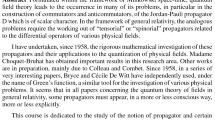Abstract
Feynman’s sum-over-paths prescription for the Dirac equation in a two dimensional spacetime can be formulated to give an unconventional view of the relationship between quantization and special relativity. By considering a local rule for the maintenance of Lorentz covariance in a discrete space, one is able to see the origin of Feynman’s rule and, taking a continuum limit at the last step, one obtains the Dirac propagator as a manifestation of special relativity, rather than a formal addition to it. In this route to the Dirac equation, the path-dependent phase of wavefunctions, relativistic or not, is a direct manifestations of path-dependent proper time.
Similar content being viewed by others
References
McKeon, D.G.C., Ord, G.N.: Time reversal and a stochastic model of the Dirac equation in an electromagnetic field. Can J. Phys. 82(1) (2004)
Wheeler, J.A.: Gravitation. W.H. Freeman, New York (1973)
Rindler, W.: Introduction to Special Relativity. Oxford University Press, Oxford (1999)
Taylor, E.F., Wheeler, J.A.: Spacetime Physics. W.H. Freeman, New York (1992)
Taylor, E.F., Wheeler, J.A.: Exploring Black Holes: Introduction to General Relativity. Addison-Wesley Longman, Reading, Harlow (2000)
Feynman, R.P., Hibbs, A.R.: Quantum Mechanics and Path Integrals. McGraw-Hill, New York (1965)
Gersch, H.A.: Feynman’s relativistic chessboard as an Ising model. Int. J. Theor. Phys. 20, 491 (1981)
Jacobson, T., Schulman, L.S.: Quantum stochastics: the passage from a relativistic to a non-relativistic path integral. J. Phys. A 17, 375–383 (1984)
Kauffman, L.H., Noyes, H.P.: Discrete physics and the Dirac equation. Phys. Lett. A 218, 139 (1996)
Gaveau, B., Jacobson, T., Kac, M., Schulman, L.S.: Relativistic extension of the analogy between quantum mechanics and Brownian motion. Phys. Rev. Lett. 53(5), 419–422 (1984)
Ord, G.N., Gualtieri, J.A.: The Feynman propagator from a single path. Phys. Rev. Lett 89(25), 250403 (2002)
Ord, G.N., Mann, R.B.: Entwined paths, difference equations, and the Dirac equation. Phys. Rev. A 67(2), 022105 (2003)
Ord, G.N.: Quantum mechanics in a two-dimensional spacetime: What is a wavefunction? Ann. Phys. 324(6), 1211–1218 (2009)
Kauffman, L.H.: Non-commutative worlds. New J. Phys. 6, 173 (2004)
Feynman, R.P.: Nobel lecture
Kac, M.: A stochastic model related to the telegrapher’s equation. Rocky M. J. Math. 4(3), 497–509 (1974)
Kac, M.: Random Walks and the Theory of Brownian Motion. MIT Press, Cambridge (1979)
Schweber, S.S.: Feynman and the visualization of space-time processes. Rev. Mod. Phys. 58, 449 (1986)
Hestenes, D.: Mysteries and insights of Dirac theory. Ann. Fond. Louis de Broglie 28, 390–408 (2003)
Author information
Authors and Affiliations
Corresponding author
Rights and permissions
About this article
Cite this article
Ord, G.N. Feynman’s Corner Rule; Quantum Propagation from Special Relativity. Int J Theor Phys 49, 2528–2539 (2010). https://doi.org/10.1007/s10773-010-0445-8
Received:
Accepted:
Published:
Issue Date:
DOI: https://doi.org/10.1007/s10773-010-0445-8



